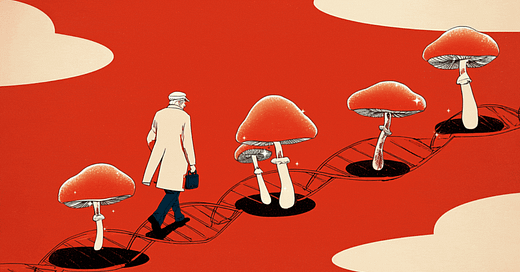Can Psychedelic Mushrooms Help Us Live Longer?
Cutting-edge research in the journal Nature explores the possibility.
A new study has found that psilocybin, the active component in "magic mushrooms", may do more than alter perception: it could slow the aging process. Researchers from Emory University and Baylor College of Medicine published their findings in npj Aging, a Nature partner journal on aging, last week, showing that psilocybin's active form, psilocin, extended cellular lifespan in human cells and increased survival in older mice.
This is the first experimental study to show that psilocybin might act as a geroprotective agent, a compound that slows down biological aging. While previous research focused mostly on its effects on mood, cognition, and mental health, this study is the first to link psilocybin to key hallmarks of aging, like telomere preservation, reduced oxidative stress, and extended cellular lifespan.
If these results hold up, they could fundamentally change how we view psychedelics, not just as treatments for mental health, but as a tool for slowing aging and extending human lifespan.
Let’s dive into it.
The Study That Sparked the Hype
To explore psilocybin’s effects on aging, researchers treated cultured human cells with psilocin, the active compound that psilocybin turns into once it's processed by the body. In this study, scientists exposed fetal lung fibroblasts (a type of cell found in the connective tissue of the lungs that are crucial for maintaining the structural framework of the lung) to both low and high doses of psilocin, then tracked how long the cells kept dividing before entering senescence, the biological “retirement” phase when cells permanently stop replicating.
The results were striking:
29% increase in lifespan at a low dose
57% increase in lifespan at a high dose
Reduced DNA damage and oxidative stress
Higher activity of SIRT1, a gene associated with cellular repair and longevity
Preserved telomere length and fewer signs of biological stress
Essentially, psilocin-treated cells didn’t just survive longer, they aged better. Their telomeres, the protective end-caps on DNA that shrink over time, were better preserved, and they showed fewer signs of biological stress.
These findings motivated the team to do a live animal study. They gave 19-month-old female mice (roughly the mouse equivalent of a 60-year-old human) a monthly dose of psilocybin for 10 months.
By the end of the trial, 80% of the psilocybin-treated mice were still alive compared to just 50% in the control group.
How is this possible?
Psilocybin primarily works by activating serotonin receptors in the brain, especially 5-HT2A. But this receptor isn’t limited to the brain. It’s found across the body: in skin cells, heart tissue, immune cells, and more.
Interestingly, past research showed that activating this receptor can trigger a chain reaction in cells that ramps up SIRT1, a gene known to protect against age-related damage and oxidative stress. That pathway could explain why psilocybin might reduce cellular aging, even outside the brain.
The study’s authors also raised the possibility that epigenetic changes, long-lasting tweaks to how genes are expressed, could be part of the story. Previous work has shown that psychedelics like psilocybin can alter gene expression for weeks or months after a single dose, possibly through mechanisms like DNA methylation or chromatin remodeling.
This might help explain the long-lasting therapeutic effects of psilocybin seen in depression and anxiety trials and now, potentially, its anti-aging properties.
That said, more research is needed, including human trials, to understand how this compound may affect a human lifespan. While the cellular and animal data are promising, translating these effects to complex human biology is no small leap. Still, the idea that a psychedelic compound could one day be used to promote healthy aging challenges long-standing assumptions and it’s a hypothesis scientists are now taking seriously.
Regulatory Barriers and Scientific Roadblocks
Even if psilocybin turns out to be a potent anti-aging compound, there’s one major hurdle: its legal status.
As a Schedule I drug in the U.S., psilocybin is still considered to have “no accepted medical use” and a high potential for abuse, a classification that many researchers and clinicians now argue is outdated.
That makes it difficult to fund large-scale trials or get approvals for broader research. And while the FDA has granted “breakthrough therapy” status to psilocybin for treatment-resistant depression, extending its use into the aging space would require a major scientific and cultural shift.
If you’re curious to learn more about the latest in psychedelic therapy, check out our full coverage from Psychedelic Science 2025, where we explore the cutting-edge research shaping the future of psilocybin. And don’t miss our interview with Sam Chapman, founder and president of the Center for Psychedelic Policy, for a deeper look at where science meets policy.
So... Should You Be Excited?
Psychedelic research is constantly evolving, and every study like this helps build a clearer picture of what these molecules can do beyond just their effects on the mind.
This isn’t just about one breakthrough finding; it’s about adding important pieces to a growing body of evidence that will help us understand psilocybin’s full potential, including its impact on the aging process.
While much remains to be explored, studies like these push the boundaries of what we know, turning questions into testable hypotheses and opening new pathways for future research.
Also, it is so so helpful to North Spore if you help spread this content (like spores to the wind). We are forever grateful for our customers and readers. Help us by sharing this post to your social media networks!








https://open.substack.com/pub/jasoncharlesgiger/p/dissolving-the-divide?r=33jyrz&utm_medium=ios